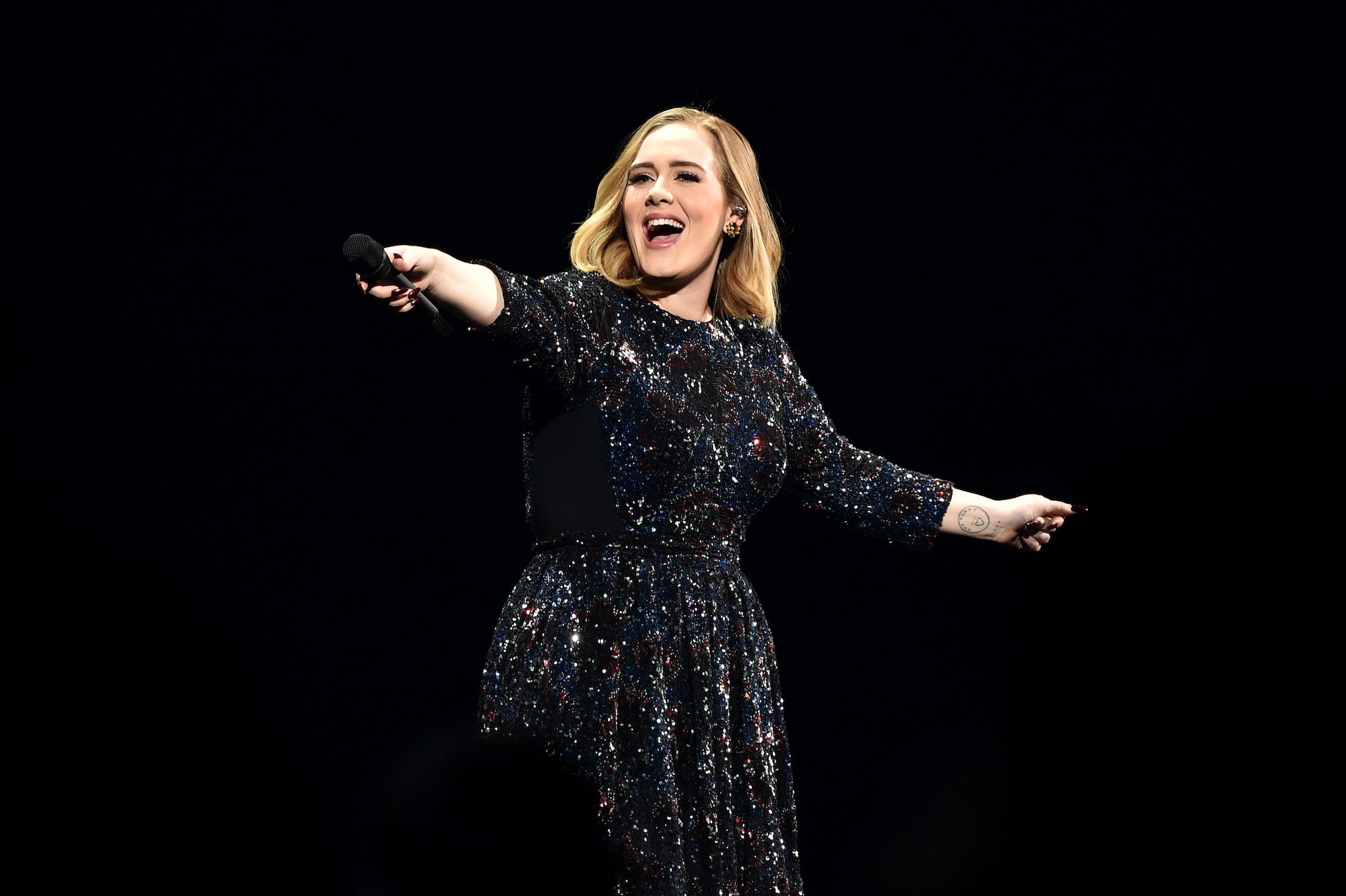Adele: the girl from north London who made the world sit up and listen
As the singer-songwriter prepares to release her new album ‘30’, Roisin O'Connor looks at what makes Adele tick and charts her road to global stardom following hits such as ‘Rolling in the Deep’ and ‘Someone like You’


“Absolute mess and inner turmoil.”
Could we want anything more from an Adele album? After months, years even, of pleading fans and media speculation, the UK star finally confirmed the title, release date and theme of her forthcoming album, 30.
Few artists, especially British ones, have been quite so capable of capturing global attention. Adele is the only person to have been given an unprecedented two simultaneous covers on Vogue US and British Vogue. Even fewer have done it without relentless campaigning, new “eras”, or overhauls of their public persona. As glamorous as she looks on those magazine covers, you only have to read the interviews to realise that Adele – no matter what size she is, what clothes she wears, or whether the winged eyeliner has been applied that day – will always be Adele.
In the five years since Adele last gave interviews, she has been married and then divorced. The famously private artist has handled scrutiny of her personal life with grace but also firmness. We know about as much as she wants us to know.
Let’s start from the beginning, then. Adele Laurie Blue Adkins was born in Tottenham, north London, to an English mother and a Welsh father. Her dad left when she was two years old – they fell out in 2011 after he gave interviews to the press about her, but she revealed to Vogue that they had managed to reconcile before his death in May this year.
“I know he loved me, and we actually got our peace before he died,” she said. “When he passed, I had this sort of physical reaction. That fear left my body.”
When she was nine, Adele and her mother moved to Brighton before relocating back to London in 1999, first to Brixton, then to the neighbouring district of West Norwood. As an only child, music became the friend she needed while trying to navigate the fallout from her father’s abandonment. “Music was the sibling I never had,” she told Vogue US. “That’s why I love Beyoncé so much. She would put out music so regularly, it would be like seeing her. It really felt like that for me. It made me feel a lot of things.” At the Brit School, she became a classmate of Jessie J and Leona Lewis; just a few months after graduating, a friend posted one of her songs on MySpace. It wasn’t long before Adele was invited to a meeting at XL Recordings – she was so convinced the offer wasn’t real that she took a friend along with her to be safe.
In terms of timing, Adele couldn’t have done better. She is a “traditional” artist in one sense, who prefers to share one or two singles before the full album rather than multiple singles over two or three years before finally releasing a full-length project. Her debut TV performance on Jools Holland in 2007, then, introduced her to a market that loves buying albums, and that tends to remain loyal to its favourites for the duration of their careers. But she first emerged via MySpace, thus also attracting a younger, streaming-savvy audience.
I was 15 when her first single, “Chasing Pavements”, was released, and it’s hard to convey just how much I related to this blue-eyed soul singer, who spoke like me and my school friends and looked a lot like me, too. “There’s something about women raised in north London,” I wrote in a comment piece last month. “We’re bolshie, excel at pub chat, don’t suffer fools, and there’s a particular kind of laugh – Amy Winehouse had it, too – that seems to be a signature trait. It’s more of a full-throated cackle that throws your head right back.”
Her debut album, 19 (named after the age she was when she recorded it), was a near-immediate phenomenon. Critics had their reservations – The Guardian gave the album two stars, while The Independent’s late critic Andy Gill awarded it three and expressed concern that Adele was being thrust into the spotlight before she was ready.
“If she were a relative unknown, this wouldn't matter much: she would develop a broader outlook at her own pace,” he wrote. “But thrust so prematurely into the limelight, Adele has to effect those changes in full view of the public, with each step reported in the mandatory weblog diary. Is it any wonder that mystique is a vanishing commodity in pop, or that the cycle of acclaim and contempt is now so rapid? 19 is a passably decent debut, but it could have been so much more by being so much less anticipated.”
However the critics felt, audiences adored Adele’s soaring vocals and her frank, candid lyrical style. 19 debuted at No 1 in the UK and eventually made the Top 10 in the US (after Adele’s Saturday Night Live performance and a double Grammy win in 2009), a feat virtually unheard of for a British female making her debut. From there, it felt as though she was single-handedly bringing the UK industry out of its doldrums, with the release in 2011 of 21, which became the biggest-selling album of both that year and the next.
Andy Gill remained unimpressed, writing: “[The album] sinks into a mire of turgid, characterless piano balladry swamped in routine string arrangements, the sole respite from which comes in the deep soul number ‘One and Only’, her best vocal performance here.” It received a more enthusiastic critical reception elsewhere, including five stars from the Telegraph and four from The Guardian. A New York Times review observed: “[Adele] can seethe, sob, rasp, swoop, lilt and belt, in ways that draw more attention to the song than to the singer.”
Commercially, the album shattered records set by Oasis and The Beatles – it now sits in the top 10 best-selling albums of all time.
Around the time Adele was achieving world-dominating fame, however, one of her contemporaries finally succumbed to its toxicity. On 23 July 2011, Amy Winehouse was found dead of alcohol poisoning. Her death greatly affected Adele.
“We watched her die right in front of our eyes,” she told Vogue. “I’ve always had a very close relationship with alcohol. I was always very fascinated by alcohol. It’s what kept my dad from me. So I always wanted to know what was so great about it.” But she had seen how Winehouse’s alcohol-induced exploits were spun into yet more tabloid fodder: “They descend, and descend, and descend on you, which drives you f***ing mad.”
Winehouse was the reason Adele first picked up the guitar. “She means the most to me out of all artists,” she said. “Because she was British. Because she was amazing. Because she was tortured. Because she was so funny.” Seeing the way Winehouse was treated made her all the more determined to have control over her own story: “I’m not having these people I don’t know take my legacy, my story away from me, and decide what I can leave behind or what I can take with me.”
She maintained this ethos when it came to the furore surrounding her “dramatic weight loss”, evidence of which first emerged in grainy paparazzi photos of her enjoying a beach trip with some celebrity friends. What no one seemed to point out was that, in fact, Adele had been out of the public eye for almost four years by this point, during which time she’d worked with a dedicated personal trainer.
The media frenzy, particularly for female fans like myself, who had finally found someone to relate to in the notoriously superficial and fatphobic music industry, was incredibly triggering. At the time, I wrote in a comment piece: “My instinctive feelings about her weight loss have been troubling because, for me, it’s a stark reminder of the difficult relationship I’ve had – and still have – with my own figure. It’s only recently that I came to terms with the fact that I’ve had an eating disorder since I was 12 years old.
“Women like Adele inspired me because she was called, and called herself, ‘beautiful’. She wasn’t thin, but she was still glamorous, talented and fun. She was unafraid to express her opinions. So now, I have to check myself from feeling ‘betrayed’ somehow by this new image. Her body is not mine, and what she does with it does not reflect the way I do, or should, treat my own.”
Adele herself acknowledged how some fans, particularly women, might struggle with their feelings about her new image. “My body’s been objectified my entire career. It’s not just now. I understand why it’s a shock,” she said. “I understand why some women, especially, were hurt. Visually I represented a lot of women. But I’m still the same person.”
Then, in the British Vogue interview, she said something that really struck me: she acknowledged that her considerable wealth had afforded her a lot of privilege, and that in turn had contributed to her ability to lose weight. When she revealed she was able to work out “two or three times a day”, she became awkward at the journalist’s marvelling over this apparent dedication.
She seemed to read it differently, understanding that she was able to do this because she could afford not to work for four years. “I was basically unemployed when I was doing it,” she said. “It’s not doable for a lot of people.”

This willingness to face up to awkward truths is one of Adele’s most endearing traits. It showed up again when she was asked about her now-notorious photo from last year, in which she wore a Jamaican flag bikini top and had her hair styled in bantu knots. “I didn’t read the f***ing room,” she said, in response to the backlash surrounding the issue of cultural appropriation. Asked why she didn’t delete the photo, she said she felt this would seem like she was trying to pretend it had never happened. “And it did,” she said. “I totally get why people felt like it was appropriating.”
Adele’s fourth album is unlikely to stray too far from her signature sound, but fans should expect a few changes, because she’s never made the same record twice. 21 remains her strongest to date, thanks to songs such as “Rolling in the Deep”, “Rumour Has It”, and “Set Fire to the Rain”, but I have high hopes that 30 will knock it from that position.
Adele had vocal surgery in 2012 and discovered when she was recording 25 that she’d added four new high notes to her already impressive register. She was forced to cancel her final stadium shows in 2017 due to a vocal cord injury, but hopefully now, after years of rest and training, she’s returning stronger than ever.
The album itself is apparently inspired by her divorce from ex-husband Simon Konecki, with whom she has a child, Angelo. But it is not a traditional “divorce album” as much as a way of explaining the split to her son, so he can listen when he’s older. She's the queen of heartbreak, but also uses music to face up to her own insecurities and indiscretions. And isn’t that why we love Adele the most? In the most beautiful way, she captures the universal feelings we are unable to express ourselves.




Join our commenting forum
Join thought-provoking conversations, follow other Independent readers and see their replies
Comments